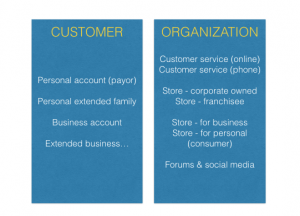As brands and organizations try to come to grips with the “omnichannel” customer and make customer centricity a reality, it is evident that there is no clear-cut solution or single path to success. The complications are legion, especially when the organization does not have a genuine culture of being customer-focused. It’s one thing for a company that believes that the customer is king and is on a mission to find a way to manage the gangly, hyper-connected, multi-platform customer. It is a wholly other challenge when the organization has long been programmed around other centers of attention (for example: product, internal careers and competition, shareholders…) and top leadership doesn’t model the behavior. The key question: to what extent is your organization prepared to wrap itself around the core customer group in the center?
A recent case I experienced bears witness to the challenges. And, I will conclude this article with some suggestions to start the path toward improvement in the quest for true customer centricity.
The initial context
For the sake of this example, I have removed the name of the telco company in question, because I believe this company is like so many others, and it doesn’t deserve any further singling out. In any event, to start with, I am a loyal and long-term client of this company. It all began when I wanted to get a new phone and went into one of their stores to inquire. I was told that the new iPhone was not available yet; but, upon looking at my contract, the energetic salesperson gave me some positive new news that I had not been expecting. My business contract allowed me unlimited speaking minutes and texting in Europe, not just in France. The problem, it turns out: she was wrong. Net result: I ended up getting hit with a sizeable premium charge to my already healthy monthly bill after using the phone blithely in my travels around Europe. So, I wanted to issue a complaint.
Where is the customer service?
In this multi-channel-of-communication world, I had a few options:
- go back to the store in question
- go to another store nearby me
- call the “hotline” (and go through a rather unclear, automated labyrinth to not end up with a live person)
- send an email
- tweet
- (note: live chat online was not an option for this case)
The issue of time is central to the way one deals with this type of affair. As a customer, we tend to want to allocate the time that suits ourselves to “deal” with the issue. Secondly, we have expectations in terms of speed of resolution. There is nothing pleasant about a lingering complaint.
The customer journey – a serpentine affair
Having expired my patience with trying to get someone on the end of the line with the “hotline,” I sent a tweet. After numerous and I must avow speedy exchanges, we concluded that I should indeed be able to claim against the overbilling. In terms of the Twitter customer service, they seemed to have a good grip on who I was. In the end, I was advised on Twitter to go to a boutique. When I managed to carve out the time, I headed out to the nearest store (which was not the same as the one where the whole journey began). With my business contract, I was immediately informed that I must go to another store which deals with business customers. No attempt was made to capture who I was. The nearest such store was half a mile away, so I headed that way since I didn’t see much other solution.
The customer-facing employee
If an employee who is customer facing is even slightly disgruntled, you can quickly tell. When I arrived at the second store, I was met by a “welcoming” agent, charged with receiving and dispatching walk-ins. When I started to explain my situation, he quickly put up his hand and told me with a wry smile (translated verbatim):
No need to tell me, Mister. I’ve heard it all before. You’ve been shunted around from one place to another and you are upset. Let me take it forward and see if I can help you!
On the face of it, that might have been ok, if it were not for what followed:
 First, he asked why I hadn’t brought a printed copy of the bill? Then, when I produced a digital copy of the latest bill, he told me it didn’t have the details. When I told him to scroll down, he found it, whereupon he told me that I was wrong about the situation. Dealing with me in between receiving other customers for what took nearly 10 minutes, he finally capitulated, saying that there was no way to deal with my situation in the store. He invited me to call customer service … in front of him! As if he needed to listen to my call? I promptly asked for his name and was set to leave. He jumped up, covered his name badge and said, as he ran off, “No way I’m giving you my name. I don’t want to get fired. I will go get the manager.” Hum!
First, he asked why I hadn’t brought a printed copy of the bill? Then, when I produced a digital copy of the latest bill, he told me it didn’t have the details. When I told him to scroll down, he found it, whereupon he told me that I was wrong about the situation. Dealing with me in between receiving other customers for what took nearly 10 minutes, he finally capitulated, saying that there was no way to deal with my situation in the store. He invited me to call customer service … in front of him! As if he needed to listen to my call? I promptly asked for his name and was set to leave. He jumped up, covered his name badge and said, as he ran off, “No way I’m giving you my name. I don’t want to get fired. I will go get the manager.” Hum!
Customer service escalation
After first asking me why I should want the “receptionist’s” name (as if I had to defend myself), the Manager provided a good ear. We settled down to an adult conversation and the manager diligently listened and fixed my situation. After more than 30 minutes with the manager including a long wait to get through to their own customer service hotline, the affair was settled satisfactorily. All’s well that ends well, for he/she who has limitless patience and time on their hands? I can’t say I was amused by the twisted journey I took. So, in taking the allegory of the apricot above, what’s an organization to do in an effort to allow the flesh and blood (employees) to nourish the core customer?
4 keys to creating a customer-centric customer service?
 Single customer view? The business cannot segment the customer information according to its P&L. My business contract is considered differently — indeed it is treated in total abstraction — from the personal contract (I am a customer at home, too). Whether it is the professional or personal relationship, I consider the telco as one big and single entity. It should do the same for me. As a mobile phone consumer, without any signage, it is not possible to understand the difference between the IRL telco stores with the same logo firmly outside. Between corporately owned and franchise stores, customer data needs to be transparent. Likewise, between stores that work with business and/or home accounts, I would suggest a level of transparency. I note that the customer service people on Twitter are able to deal with both of my “personalities” (i.e. personal and business).
Single customer view? The business cannot segment the customer information according to its P&L. My business contract is considered differently — indeed it is treated in total abstraction — from the personal contract (I am a customer at home, too). Whether it is the professional or personal relationship, I consider the telco as one big and single entity. It should do the same for me. As a mobile phone consumer, without any signage, it is not possible to understand the difference between the IRL telco stores with the same logo firmly outside. Between corporately owned and franchise stores, customer data needs to be transparent. Likewise, between stores that work with business and/or home accounts, I would suggest a level of transparency. I note that the customer service people on Twitter are able to deal with both of my “personalities” (i.e. personal and business).- Employee engagement is absolutely vital to providing excellent customer service. When fear of being fired is even raised in front of the client, you can sense the malaise. What programs do you have in place to gauge and enhance customer engagement? Do you treat your employees in the same way that you hope to treat your customers?
- Information and Communcation. Data and customer information is at the heart of a strong customer centric culture. For this reason, employees who are customer facing must be equipped with and/or have access to the right information in lightning fast speed. In this accelerated world, internal communications teams must spend considerable energies bringing the employee network up to speed, to be at the same level of information as much as possible. Having a culture of rapid response and decision-making is crucial.
- Accountability and front line delegation. Assuming your employees are engaged, committed and well-informed, the last piece of the customer centricity pie is their being empowered to manage the client at the time of contact. With empowerment, accountability can become a reality. Without accountability, customer centricity will remain a slogan in the corporate brochure. {Tweet this!}
Your comments and reactions are welcome!














Trackbacks/Pingbacks